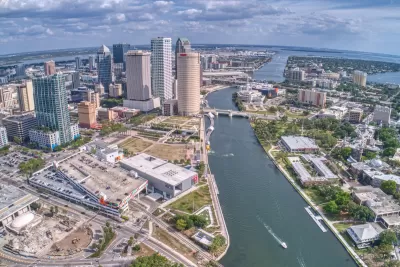One-third of the city’s downtown is used for parking while thousands of parking spaces go unused during peak hours.

A survey of land use in downtown Tampa, Florida reveals that one-third of the area is taken up by parking, a finding echoed in a recent similar study of Salt Lake City. Meanwhile, 6,000 of 24,000 downtown parking spaces went unused during peak hours, reports Kate Oberdorfer in Creative Loafing Tampa Bay.
According to the article, “Since 2020, Tampa City Council has approved over 100 rezonings where the number of parking spots was waived below what the code required. Last year, the city controversially slashed free parking in Ybor City by 26%. Council has also approved amendments to the downtown zoning code and is working with the Mobility Department and Parking Division to draft a Parking Master Plan to address the parking issue.”
Neighboring St. Petersburg gives up 24 percent of its downtown land to parking, but the city’s Transportation and Parking Management Director, Evan Mory, says “the Sunshine City is softly and systemically reducing the number of surface parking lots; replacing these lots with structured parking as well as re-purposing the land for more people-friendly spaces.”
But Mory also added that “surface parking lots are good place holders; they’re consistent income for the city and they keep property taxes down. Until the city can figure out how to better develop the lots, surface parking isn’t such a terrible use of the land.”
FULL STORY: A third of downtown Tampa is parking lots, city planners say they are actively trying to fix that

Alabama: Trump Terminates Settlements for Black Communities Harmed By Raw Sewage
Trump deemed the landmark civil rights agreement “illegal DEI and environmental justice policy.”

Planetizen Federal Action Tracker
A weekly monitor of how Trump’s orders and actions are impacting planners and planning in America.

The 120 Year Old Tiny Home Villages That Sheltered San Francisco’s Earthquake Refugees
More than a century ago, San Francisco mobilized to house thousands of residents displaced by the 1906 earthquake. Could their strategy offer a model for the present?

In Both Crashes and Crime, Public Transportation is Far Safer than Driving
Contrary to popular assumptions, public transportation has far lower crash and crime rates than automobile travel. For safer communities, improve and encourage transit travel.

Report: Zoning Reforms Should Complement Nashville’s Ambitious Transit Plan
Without reform, restrictive zoning codes will limit the impact of the city’s planned transit expansion and could exclude some of the residents who depend on transit the most.

Judge Orders Release of Frozen IRA, IIJA Funding
The decision is a victory for environmental groups who charged that freezing funds for critical infrastructure and disaster response programs caused “real and irreparable harm” to communities.
Urban Design for Planners 1: Software Tools
This six-course series explores essential urban design concepts using open source software and equips planners with the tools they need to participate fully in the urban design process.
Planning for Universal Design
Learn the tools for implementing Universal Design in planning regulations.
Clanton & Associates, Inc.
Jessamine County Fiscal Court
Institute for Housing and Urban Development Studies (IHS)
City of Grandview
Harvard GSD Executive Education
Toledo-Lucas County Plan Commissions
Salt Lake City
NYU Wagner Graduate School of Public Service





























